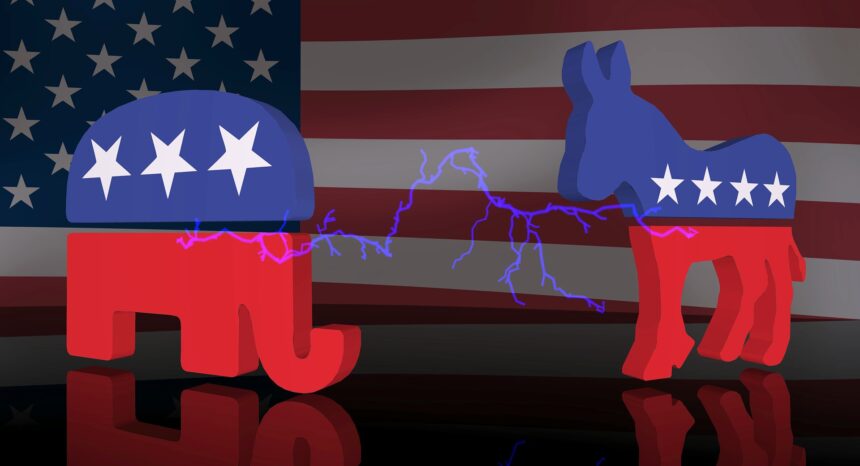
In the weeks leading up to the 2020 U.S. election, Thomas E. Patterson is writing a series of research-based pieces examining election-related topics and how journalists cover them. Patterson is Bradlee Professor of Government and the Press at Harvard Kennedy School and author of the recently published “Is the Republican Party Destroying Itself?” He also conceived Journalist’s Resource and oversaw its initial development.
In a study of news coverage of the 2000 U.S. presidential election, the Project for Excellence in Journalism and the Pew Research Center found something that astonished the researchers in the 2,404 stories and broadcasts they studied. Nearly all of journalists’ references to George W. Bush’s intelligence, a dominant theme of his coverage, were unfavorable. Al Gore was also typecast. Nearly all of journalists’ references to his trustworthiness, a dominant theme of his coverage, were negative in tone. When the researchers probed deeper, they found that reporters’ characterizations of the two candidates were established early in the campaign and became self-perpetuating. When Gore misquoted a statistic, even if off by only a few percentage points, it became a news story about whether he could be trusted. When other candidates made a similar misstatement, reporters ignored it. And as the campaign unfolded, nuance disappeared. Journalists came as close as newsroom rules allowed to calling Bush “dumb” and Gore “a liar.” The research team, led by Tom Rosenstiel, who now heads the American Press Institute, used the term “meta-narratives” to describe the characterizations.
Journalist and author Walter Lippmann worried about the tendency of journalists to rely on stereotypes in his 1921 classic, Public Opinion. He noted that stereotyping leads journalists to “see chiefly what [their] mind” tells them to see. Rosenstiel reached a similar conclusion about meta-narratives, saying that they can “overwhelm the facts” and become “a distorting lens.” Said Rosenstiel, “[Meta-narratives] can lead journalists to ignore and mischaracterize facts as they try to fit them into the story.” When they take root, meta-narratives blunt reporters’ ability to counter them. In a 2001 article in The Washington Monthly, Rosenstiel and former journalist Bill Kovach wrote: “One difficulty is that the narrative tends to trump reporters’ judgment. It becomes difficult for an individual reporter to write a story that differs from the popular meta-narratives.”
Subsequent research has found the same pattern. In my study of 2016 election coverage, for example, I found that Hillary Clinton was portrayed as distant and robotic, and less than trustworthy. That characterization contributed to journalists’ obsession with her emails, such that in the general election negative references to her trustworthiness outpaced references to her policy positions in leading news outlets by four to one. In turn, the meta-narrative raised the newsworthiness of Donald Trump’s attacks on her character.
Research indicates that meta-narratives affect voters’ perceptions of the candidates, particularly among those who closely follow the news. Over the course of the campaign, they increasingly embrace journalists’ depictions of the candidates.
Among the meta-narratives in the 2020 campaign is the notion that Joe Biden is cognitively impaired. Biden has been prone to gaffes and misstatements throughout his career. Is it worse today? And if it is, is it due to mental decline or a tendency to tire more quickly? Journalists are not equipped to authoritatively answer those questions. Yet the storyline persists, adding weight to Trump’s mocking “Sleepy Joe” refrain.
Meta-narratives have a role in election coverage. Journalists need shorthand ways to talk about the candidates. But they also can be a disservice to the voters when they blind journalists to disconfirming evidence and hijack their storylines. As Rosenstiel noted: “In a way, these master or meta-narratives are the modern equivalent of pack journalism. While the reporters are no longer all standing together in a group, literally looking over each other’s shoulder as they write, they tend to synthesize and react to each other’s coverage to such an extent that it can be difficult for candidates to escape the impression created by these narratives or to project a different one.” Rosenstiel and Kovach warned that meta-narratives pose “grave risks for journalists.”
Further reading:
Bill Kovach and Tom Rosenstiel, “Campaign Lite: Why reporters won’t tell us what we need to know,” Washington Monthly, January/February, 2001.
Pew Research Center, “The Master Character Narratives in Campaign 2012,” August 23, 2012.
Thomas E. Patterson, “Pre-Primary News Coverage of the 2016 Presidential Race: Trump’s Rise, Sanders’ Emergence, Clinton’s Struggle,” June 13, 2016.


Expert Commentary